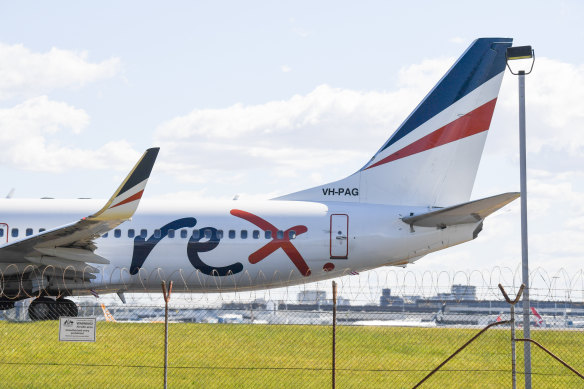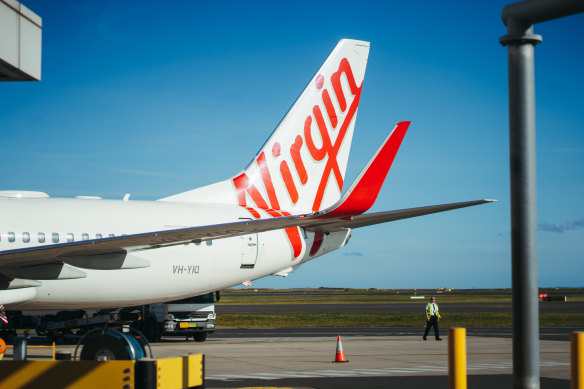Opinion
Back to the future: What Rex needs to do to survive
Stephen Bartholomeusz
Senior business columnistThe failure of Rex Airlines was predictable because it is all too familiar.
Over more than three decades, we’ve seen a succession of new entrants to the Australian domestic aviation market, generally from regional backgrounds, try to gatecrash the lucrative “golden triangle” Melbourne-Sydney-Brisbane routes that are the core of Qantas’ and, more recently, Virgin’s profitability.

Rex launched capital city services as part of a new strategy, putting it in competition with Qantas and Virgin Australia.Credit: Peter Rae
In 1990, Bryan Grey, then operating East-West, a profitable regional airline, launched Compass Airlines as a low-cost carrier to compete with Qantas and Ansett. It lasted just over a year before collapsing.
Two years later, Southern Cross Airlines launched Compass Mark II. It didn’t make it to its first birthday.
In 2000, another successful regional operator, Gerry McGowan, launched Impulse Airlines. On the verge of collapse in 2001, it was sold to Qantas, providing the flag carrier with an expanded QantasLink regional business and the platform for the launch of Jetstar.
The Singapore Inc-backed Tiger Airways, which entered the Australian market in 2007, struggled to compete, racking up losses, even after Virgin bought into it in 2013 and took control a year later. It disappeared at the onset of the pandemic amid Virgin’s collapse.
There were others – Air Australia, OzJet and, more recently, Bonza – but the story has remained the same.
The aspiring challengers looked at the profits Qantas and, briefly, Ansett and Virgin were making on the golden triangle routes and thought that, as new entrants with lower costs, they could grab a share from the less nimble incumbents.
Rex, a well-run and profitable regional airline (albeit that its profits have been propped up by state and federal government subsidies and “managed” monopolies on small regional routes) thought it had discovered a historic opportunity when the pandemic plunged Virgin into administration and Qantas into massive losses.
It had a profitable history, a low cost base, existing infrastructure, and a loyal passenger base. However, the pandemic had created a massive pool of cheap aircraft, unemployed pilots, and vacant slots at the major airports.
With the backing of an Asian private equity group, PAG Asia Capital, which provided $150 million of convertible note funding and a $175 million Westpac facility, Rex launched on the strategic routes in 2021 with an initial fleet of nine Boeing 737-800s, mostly acquired from Virgin’s administrators.
Rex has failed, despite what appeared to be the near-perfect opportunity, one not dissimilar to that which enabled the original Virgin Blue to take advantage of Ansett’s collapse and establish itself as a very profitable second domestic player to Qantas.
It should have learned from history and, indeed, from Virgin’s experience.
Virgin Blue, with its cost advantage over Qantas, was very profitable until it decided – with the backing of several of the world’s larger airlines and their balance sheets – to directly challenge Qantas and its dominant market share. As Virgin moved upmarket, adding lounges and a loyalty scheme to an above-ground product that rivalled Qantas’ and competed for its core business customers, Qantas responded.
Jetstar cut prices and added capacity on Virgin’s tourism routes, while Qantas did something similar on the trunk routes. Even without the pandemic, an overly leveraged and consistently loss-making Virgin would have needed to be restructured and its strategy reconsidered if it were to survive. It didn’t, collapsing into administration the moment the pandemic hit.
The “new” Virgin, now owned by Bain Capital, has been more “disciplined” and profitable. It competes with Qantas, but not so fiercely that it will force an aggressive response.
Establishing a third competitor on the trunk routes in this market is challenging, and Rex and its predecessors failed to overcome many obstacles.
The Australian market is small relative to those in the US, Europe and Asia, which sustain multiple domestic full-service and low-cost carriers. It’s also a unique market, with dense population clusters concentrated in three capital cities on Australia’s east coast.
There aren’t the big secondary airports in those capitals, like those that exist offshore, to enable a low-cost attack on those routes. Slots, particularly at Sydney Airport, which is congested and has a curfew, are scarce and dominated by the incumbents.
Aviation is an extremely complex and capital-intensive business, with high fixed and variable costs generating unusually high operational leverage. There are small margins between generating big profits or incurring large losses.
Qantas and Virgin have large fleets with well-established brands, have established infrastructure, dominate the landing slots, lounges and loyalty programs, and have the ability to funnel international traffic onto their domestic networks from their operations or alliances with offshore airlines.
They also have, after Virgin was recapitalised by Bain, big balance sheets and lots of capacity, which means they can offer a frequency of flights that no newcomer can match. That’s a massive competitive advantage.

Virgin moved quickly to help affected Rex customers.Credit: Dion Georgopoulos
Rex had none of those advantages. It didn’t have enough capital or planes and, while bleeding cash and incurring losses, struggled to get more than a 5 per cent foothold in the market.
Rex and the usual Qantas bashers will now line up to complain about the anticompetitive behaviours of Qantas and (inevitably to a lesser degree) Virgin, which predictably responded to Rex’s attempt to gatecrash their key routes by adding capacity, cutting prices and targeting Rex’s own most-profitable regional routes.
It is peculiar that those who advocate for more competition in aviation see it only in terms of the challengers and would like to see the incumbents, particularly (and maybe solely) Qantas, hobbled.
If the objective is to have a more competitive sector, then it will only be realised if all the competitors – including the incumbents –are allowed to compete.
The Australian domestic aviation market looks like, and the history of failed challengers suggests, a natural duopoly because of the unusual population distribution and the challenges of distance provided by the geography.
While Rex has become the latest to discover just how difficult, if not impossible, it is to crack the duopoly, it may yet have a future, although it will be very much a case of going back to the future.
Its regional business, while it has challenges of its own – half its ageing fleet of small SAAB 340s is grounded because of a global scarcity of parts – could be salvaged.
Indeed, it appears Virgin wants to help salvage it. Virgin moved quickly to offer its planes if Rex customers needed to rebook flights, invited Rex employees to apply for jobs, and said it intended to partner with Rex’s regional business via code share or interline agreements that would feed Rex’s traffic into Virgin’s network and/or international alliances. Virgin is a possible buyer of the Rex regional business – it would strengthen its own network and be a stronger competitor against Qantas domestically – but could achieve most of the benefits through a capital-light relationship with whoever emerges with control of Rex.
More competition doesn’t necessarily require more competitors.
The Business Briefing newsletter delivers major stories, exclusive coverage and expert opinion. Sign up to get it every weekday morning.